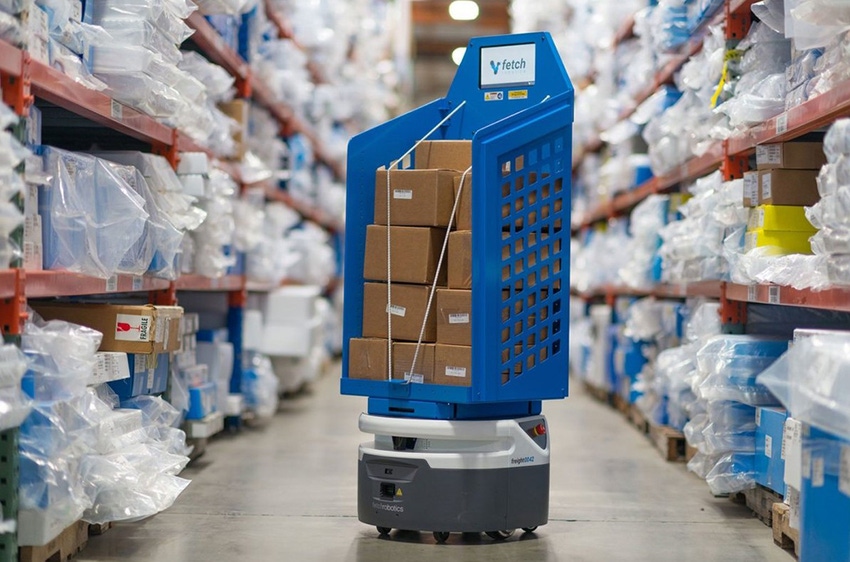Fetch Robotics and Zebra partner to accelerate warehouse automation.
April 24, 2020

The COVID-19 pandemic is poised to accelerate adoption of autonomous mobile robots (AMRs) to ease supply chain backlogs.
Even before the coronavirus pandemic shut down the global economy, leading companies that distribute large amounts of goods were deploying, or evaluating, AMRs such as DHL and Ryder. UPS yesterday announced that it has begun deploying AMRs in some of its facilities to consolidate orders.

UPS’s Philippe Gilbert
UPS wants to “create more custom and turnkey outsourced fulfillment services to meet our customers’ unique supply chain needs,” according to a statement from Philippe Gilbert, UPS’s president of supply chain solutions.

IDC’s Remy Glaisner
The weak link in warehouse automation efforts is the shortage of people to fulfill the steady rise in e-commerce transactions. The shift to e-commerce has changed the way goods are distributed. COVID-19 has now exacerbated that, which has generated more attention on AMRs, said analyst Remy Glaisner, IDC’s research director covering robotics and drones.
“I would say the COVID-19 outbreak resulted in a considerable increase in inquiries from business leaders who are wondering how the deployment of modern AMR systems can help them ensure the availability of essential goods where and when they are needed,” Remy said. “Supply chains are heavily disrupted, to say the least, so business and technology executives’ critical endeavor turns into ensuring they can reallocate capacities on the fly to meet sudden local and tactical surges that are practically unpredictable.”
COVID-19 will also boost use of mobile robotics for disinfecting, monitoring and surveillance, lifting the market to $23 billion next year, according to ABI Research. Analyst Rian Whitton sees COVID-19 helping deal with increased e-commerce activity to provide more automation in warehouses, as well as distribution and fulfillment centers.

ABI’s Rian Whitton
“The pandemic is going to have far-reaching consequences for the next five to 10 years, with a big focus on building more resilient supply chains,” Whitton said. “Though there will be an attempt to revert to business as usual, more local supply chains for key equipment will be prioritized and extended to durable goods. In order to facilitate further diversification of the manufacturing supply chain, there will have to be a lot more robots.”
Among those who offer autonomous mobile robots for warehouse automation and order fulfillment are Fetch Robotics, Geek+, Locus Robotics and Vecna Robotics.

Fetch Robotics’ Barry Phillips
Since the COVID-19 crisis emerged, Fetch Robotics fielded an estimated 64% increase in inquires for its AMRs, according to CMO Barry Phillips. “If you can have a robot move material instead of having a human move it, that just means that human is going to be much more productive,” Phillips said.
Fetch Robotics, among the early movers with a broad portfolio of different robot options, has a cloud-managed solution. It has AMRs that handle data collection as well as materials transport.
Zebra Technologies, best known for its industrial mobile scanners, hand-held and tablet computers, and other edge devices, is also making moves into robotics. A year ago, Zebra revealed it has taken stakes in Plus One Robotics and Locus Robotics, through its venture investment business.
In December, Zebra launched FulfillmentEdge, a solution designed to extend warehouse management systems (WMSs) from providers such as Blue Yonder (formerly JDA), HighJump Software and Manhattan Associates. Fulfillment Edge provides real-time workflows to and routes orders to mobile workers and robots for picking, sorting and packing.
Last month, Zebra announced a partnership with Fetch Robotics. Zebra this week held a webinar to discuss the partnership with Fetch and the opportunity it sees for robots to play a role in the supply chain.
Specifically, Fetch Robotics has integrated Zebra’s FulfillmentEdge with its various autonomous mobile robots. Zebra claims fulfillment Edge with Fetch Robotics AMRs will help edge to perform more accurate fulfillment and more efficient workflows and remove manual processes. While Zebra’s FulfillmentEdge provides warehouse optimization by syncing with WMSs and other backend systems, it also connects with select hardware from the company. Notably, Zebra launched its new HD4000 head-mounted display, that gives industrial workers real-time views tied to workflows for order processing, repair and use in production
Asked why Fetch Robotics opted to partner with Zebra rather than build its own WMS optimization software, Phillips said, “We decided that is not something we were going to do. There will be WMS…
…companies to do this on their own. Zebra has theirs, Honeywell has theirs.”

Zebra’s Todd Boone
These advances were starting to create demand to bring or extend the use of AMRs in distribution. COVID-19 has bolstered the case for it, said Todd Boone, director of product management at Zebra. Social distancing from the pandemic has created a surge in online ordering that has visibly choked supply chains worldwide. “Although we’ve been talking about demand driving up for e commerce, COVID-19 is actually exacerbating that issue even more,” Boone said during this week’s webinar.
Phillips noted because its AMRs are controlled on a cloud-based platform, partners and customers can deploy and manage them remotely.
Still, the technology is in its early capabilities. Robots can help workers in warehouse gather goods faster, but at this point their role is incremental.
“While the commissioning of robots can effectively be performed as a one-off, it usually it is only for relatively simple deployments,” IDC’s Glaisner said. “In such setups, robots work mostly in isolation from other operational and business systems. As a result, quickly deployed robots bring limited support, and primarily to highly local and tactical tasks. For robotics to be fully exploitable, the technology must be capable of becoming a synchronized element within a broader, complex data-centric environment.”
In that regard, the Fetch-Zebra partnership goes in the right direction, according to Glaisner. “Zebra’s portfolio of solutions is made of several interconnecting technology blocks and adding AMRs to the stack is almost a natural move,” he said.
Nevertheless, as the economy continues to deteriorate, Glaisner said near-term spending in robotics is slowing down. “The slowdown is uneven, with North America displaying the most aggressive willingness to spend on robotics,” he said. “Asia is lowering spending expectations after initially leading the charge.”
Read more about:
AgentsAbout the Author(s)
You May Also Like


